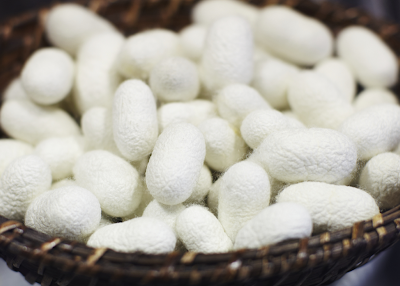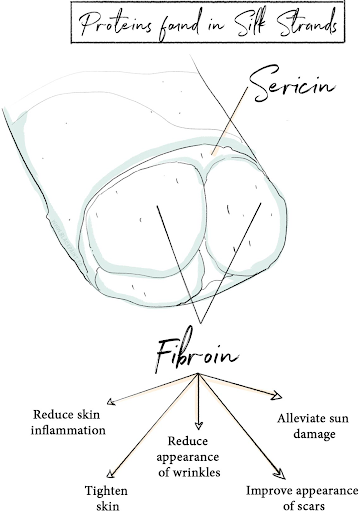
What is Silk?
Silk is a natural protein fiber, composed of mainly of fibroin and is produced by certain insect larvae to form cocoons. Silk has a smooth, soft texture that is not slippery, unlike many synthetic fibers. The best-known silk is obtained from the cocoons of the larvae of the mulberry silkworm Bombyx mori reared in captivity. Silk is mainly produced by the larvae of insects undergoing complete metamorphosis.
India is the second largest producer of silk in the world after China. Because of its texture and luster, silk rapidly became a popular luxury fabric and was in a great demand, became a staple of pre-industrial international trade.
Silk is being used in clothing, furniture, medicine, biomaterial and as many other commercial and industrial products.
Proteins in silk
Silk emitted by the silkworm consists of two main proteins, sericin and fibroin, fibroin being the structural center of the silk, and sericin being the sticky material surrounding it. Fibroin is made up of the amino acids Gly-Ser-Gly-Ala-Gly-Ala and forms beta pleated sheet.
Silk and the beauty industry
The silk extracts are so highly favored in the beauty industry because of these two proteins – sericin and fibroin (which are built from 18 amino acids). These have a chemical composition rather similar to the makeup of human skin and hair. That’s why it’s a compatible product for the maintenance of our skin and hair.
Hydrolyzed silk lends shine, elasticity and a smooth feeling to our skin and hair. Even when dry, it forms a protective crystalline surface that is not sticky to the touch, meaning that it’s both effective and cosmetically elegant. When used in leave-on skincare products, hydrolyzed silk protein can help the skin’s water barrier to retain moisture. At the same time, it also provides an attractive sheen. It’s no wonder hydrolyzed silk is widely used in cosmetics, body, skin and haircare industries in recent times.
Silk in skincare
Silk proteins are easily absorbed into the skin and boast the following benefits:
- Promotes cell repair.
- Promotes cell regeneration.
- Reduces transdermal water loss and hence helps to maintain the skin’s hydration levels.
- Boost a collagen level, which leads to firmer skin.
- Smoothens out wrinkles.
- Increases blood circulation to tissues.
- Fades out scars on skin.
On skincare forums and articles across the internet, many swear by the use of silk cocoons as an exfoliant for washing the face, as it is claimed that it:
- Has anti-aging properties (by smoothing out wrinkles and scars on your skin)
- Is gentle and less abrasive than other types of exfoliants,
- Can protect against sun damage particularly that from UVB rays.


Fibroin is the most used product in skincare industry as this protein has a high percentage of glycine and alanine as this combination gives a remarkable effect on skin.
Fibroin alleviates skin inflammations, tightens skin, Fibroin can help in ‘plumping up’ the skin, reducing the appearance of wrinkles. Some have touted it as an alternative to Botox in this regard.
Fibroin increases blood circulation to scar tissue. It is also useful for damaged skin, thus reduces the appearance of scars.
Fibroin is useful for those seeking to change the appearance of aging skin, improving its elasticity and rejuvenating its appearance.
Silk in haircare
As mentioned earlier hydrolyzed silk protein can be highly beneficial to hair too, and works by coating the cuticles of the hair strands. This seals in the moisture and protects the bonds in our hair so that it looks smoother and straighter. The other bonus points are it promotes hair regrowth and adds shine, giving hair a more lustrous and healthy appearance.
Combination of keratin and sericin together amazingly enables the product to penetrate the individual hair strands more easily and to strengthen damaged hair caused by harsh chemicals, heat or coloring treatments, and others.
Apart from the above, the sericin barrier can prevent direct contact between hair and certain harsh chemicals. As such, this prevents hair damage such as those attributed to harsh chemicals or environmental toxins and pollutants.


